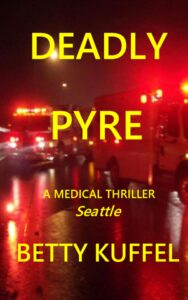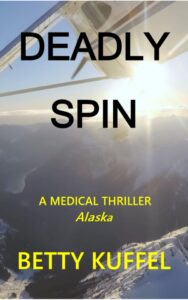by Debbie Burke

Dr. Betty Kuffel
In 2004, a small plane carrying Dr. Betty Kuffel, her husband, and their dog crashed into a remote, snowy Idaho mountain, leaving her leg crushed and dangling with bones exposed.
Where most people would be consumed by helpless panic, Betty stayed calm.
With her husband trapped in the inverted cockpit and the frightened dog circling the wreckage, Betty eased herself through the broken windshield to the icy ground.
She used the radio headset and wires to align her multiple fractures and tied the wires to hold the leg in place.
Yeah, she set her own broken leg.
Yeah, she’s Superwoman.
(Happy ending—all were rescued and survived.)
This example is one of many reasons why Betty has been my trusted medical advisor, critique partner, and dear friend for 30 years. Today, I’m happy to welcome her to TKZ with her guest post entitled:
Death and Dying for Authors
I had a plan for killing someone in one of my novels and wanted to make the death look natural with no discernible cause even with detailed postmortem forensics. To validate my plan, I called a forensic pathologist friend and said, “Dale, I want to kill someone, and I need your help.” He laughed, listened to my scenario, and confirmed my plan was correct. The cause of death would be indeterminate.
Writing accurate medical scenes is as important in fiction as it is in nonfiction. You can’t “just make it up” and make it believable. Research may save you from deadly reviews. Some experts may initially be taken aback by your questions but, in my experience, they love to help.
My background is ER medicine, wilderness hiking, climbing, dog sled racing and flying, which provided personal exposure to gruesome injuries and medical emergencies. Writing some scenes is easy because I’ve observed emotional reactions of patients and families affected by a heart attack, severe trauma from violence, gunshot wounds, and even bear mauling victims. But many writers may not have that firsthand experience.
Understanding “normal” body functions as a baseline is a great help to writers when designing a health-related scene.
First, identify your goal. Are you looking for a health challenge for your character to make him unique, a chronic disease perhaps? Or does your storyline require something acute, painful, or disfiguring? Or is this a climactic scene of violence and death?
To write the end, you need the beginning.
Basics of Life: Average adult vital signs are a blood pressure of 120/80, heart rate of 70 beats per minute, respiratory rate of 15 times per minute, and temperature 98.6 F. Blood volume: 5 liters for about a 150-pound person. At a heartrate of 70/minute with a stroke volume of 70 ml (volume pumped with each beat) = 4,900 ml ~ 5 liters. This means the entire blood volume is pumped each minute.
Basics of Death: There is wide variation in vital signs with normal activity. With smart watches and wrist exercise monitors, most writers know exercise or stress change the baseline measurements. Running up a flight of stairs will spike both heart rate and blood pressure, but they normalize with a few minutes of rest. What if they don’t normalize? How long will it take to die without oxygen, or to bleed out? You need to know some details to write an accurate life and death scenario.
Having norms in mind for comparison, you are ready to alter them to your character’s detriment and your scene’s enhancement.
It’s time to create a crisis involving (A) the airway, (B) breathing, (C) cardiac function or (N) Neuro/Brain function.
Anyone who has taken a CPR class knows these ABCs. Interruption of airway, breathing or heart function can create a crisis. Brain injury can maim or kill. So, what do you need in your scene?
A Few ABC Scenarios
Airway and Breathing:
Airway obstruction using a ligature around the neck takes moments to interrupt blood flow to the brain and cause loss of consciousness: if not released, it causes death. It’s silent and fast. A shoelace, cable ties, fish line or luxurious silk scarf will do.
The scene can start calmly but quickly change to deadly, requiring immediate interventions to save a life. During a romantic candlelight dinner in an elegant restaurant, choking causes chaos in public and brings paramedics to the scene. Is it an unexpected aspiration of a bite of steak that occludes the airway? Or did the perpetrator know about the victim’s deadly allergy to penicillin and slipped it into their food, causing death from airway swelling and hypotension?
A penicillin-sensitive person who has intercourse with someone who has taken penicillin can result in anaphylaxis and death. The lover with that knowledge can turn a romantic interlude into murder.
Drug overdoses, sedatives (ex. Valium, Ativan, Xanax) and opiates (ex. heroin, fentanyl, morphine, oxycodone), slow respiratory rate, leading to unconsciousness, airway compromise, and death. The drug Narcan (naloxone) can be given as a nasal spray or injected, reversing opioid effects within minutes. So, from unconsciousness and near death, a victim can become alert and fighting medics.
However, Narcan does not reverse the effects of sedatives.
Rapid breathing of 40 times a minute or more can be caused by a collapsed lung, chronic lung disease with failure, asthma, fright and panic attacks. All have unique causes and need interventions to control the symptoms. Some are scary but not fatal. Others are life threatening. Symptoms with impending death include rapid breathing with gasping, holding the chest or throat, being unable to speak. Skin may be mottled and bluish followed by unconsciousness.
Blood Pressure
Lowering blood pressure is an easy way to cause loss of consciousness due to reduced blood flow to the brain. Without reversal this will be fatal.
Hemorrhagic shock can result from a stabbing or gunshot wound. How long will it take to bleed out?
Hemorrhagic shock is determined by volume lost. A blood donation is Class I shock. Class II is 750-1500 ml and is initially treated with high volume IV saline, but as loss progresses fluids and blood must be pumped in. Class IV occurs when 40% of blood is lost. Unless blood loss is stopped and high-volume blood is transfused, loss of consciousness occurs. The pulse becomes rapid, then fades as the blood pressure drops into the 70s. The skin pales, pupils dilate, and the heart stops.
Here’s another way to reduce blood pressure:
The victim takes an erectile dysfunction drug like Cialis and the killer slips a few nitroglycerin tablets into his wine. He loses consciousness during intercourse because this deadly combination results in irreversible low blood pressure, shock and death. Who would know but the perpetrator?
Heart Function
A cardiac arrest means the heart stopped beating. This can result for many reasons. It is not a “cause of death.” Even young healthy athletes drop dead, but the most common cause of sudden death is narrowing of the coronary arteries that supply the heart muscle with oxygenated blood.
Heart muscle cells become unstable with lack of adequate oxygenated blood. The irritability results in loss of an organized rhythm and no contractions to pump the blood. CPR with external compressions of the chest and rapid use of an AED (Automated External Defibrillator) can save lives which is why AEDs are available in public venues like malls, airplanes, and football fields.
Cardiac arrest is the most likely scenario to result in death or brain injury due to lack of oxygen.
What does sudden death look like?
No matter what the cause–a blow to the chest or a heart attack from cholesterol narrowing of a heart artery–when the heart stops, symptom onset is abrupt and often follows this pattern: Slump, fall, with rapid total muscle relaxation; a generalized seizure due to lack of brain oxygen; mouth and eyes may be partially open; no pulse; no breathing; skin, pale, then lips and nailbeds turn blue; no movement; pupils dilate widely, fish-eyes.
Rapid Ways to Kill
A few drugs that work rapidly are easily available in medical facilities, veterinary clinics, and ambulances: Succinylcholine is a paralytic. Potassium intravenous stops the heart. Nitroglycerine overdose under the tongue drops blood pressure. Intravenous insulin overdose results in unconsciousness and death.
Drug or alcohol intoxication and exposure to cold that causes hypothermia hasten death.
Strangulation with hands or a ligature is close, personal, fast and quiet.
Slashing through neck vessels and trachea results in airway interruption and rapid hemorrhagic death.
Ways to do research:
Interview experts such as physicians and even morticians.
Google reputable sites such as universities and NIH.
Consider going on ambulance and police ride-alongs for firsthand information.
Summary:
A writer doesn’t need to include too many details or the story risks sounding like a textbook. Choose the means of death, then incorporate enough information to be accurate but not overwhelming.
~~~
Betty, you “killed it “with that comprehensive overview. Thanks for sharing your extensive knowledge!
~~~
TKZers: Does this post help you write about dying and death? Will the information alter how you commit fictional crimes?
~~~
Dr. Betty Kuffel is a retired ER physician who lives in Montana. Medical and wilderness experiences, flying, dog sled racing in Alaska, and surviving a plane crash in the mountains of Idaho fuel her writing. She writes across genres, including a medical thriller series and True Crime.




